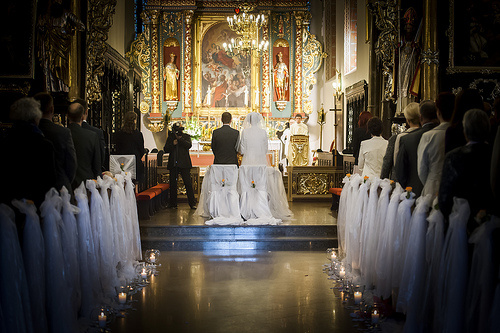Preparing Your Wedding Liturgy
A walk through the liturgy: Introductory Rites

Preparing your Wedding Liturgy
The form of the liturgy is different depending on whether the Wedding takes places in the context of Mass or outside Mass. The Introductory Rites have a common purpose to form those present into one Body and prepare them to celebrate the rest of the liturgy well.
Weddings within Mass
The Priest makes the Sign of the Cross and greets the people (The Lord be with you…). He will then introduce the celebration. This is followed by the Gloria (Glory to God in the highest) and then the Collect or Opening Prayer.
Choices
There are a number of choices for the Priest to make for the Greeting and the Collect. Some couples may wish to choose the Collect, but there are other elements which are more important to choose first.
The Gloria is a text which is intended to be sung. It can be sung:
- all the way through by everyone,
- responsorially - i.e. a short response is sung by all with the rest of the text sung by a cantor or choir,
- or it can be sung just by the choir.
It is possible to say the text but it will feel quite flat. The organist or music director will be able to advise you on suitable settings.
Weddings without Mass
The Priest (or Deacon) makes the Sign of the Cross and greets the people (The Lord be with you…). He will then introduce the celebration. This is followed by the Collect or Opening Prayer. There is no Gloria.
Choices
There are a number of choices for the Priest (or Deacon) to make for the Greeting and the Collect. Some couples may wish to choose the Collect, but there are other elements which are more important to choose first.
An Opening Hymn?
The liturgical text envisages that the Entrance Procession will be accompanied by singing. It is noted above that this is not necessarily people’s expectation. Because we are used to having a hymn at the beginning of a liturgy couples often want to include a hymn at this point.
It can either be placed:
- directly after the Entrance Procession once everyone is in place
- or after the Sign of the Cross and Greeting.
The advantages of a hymn at this point are:
- it can draw different people together into one voice
- it can help establish the spirit of the celebration.
The disadvantages are:
- by adding a hymn in at this point it can disrupt the flow of the liturgy.
- in Catholic liturgy we usually sing hymns to accompany something else happening in the liturgy. It can therefore be slightly unusual to just ’stand and sing’.
- many musicians would suggest in general that unless you know that everyone is going to sing not to have hymns
More information
- Music for the Liturgy - the Gloria
- Hymns
